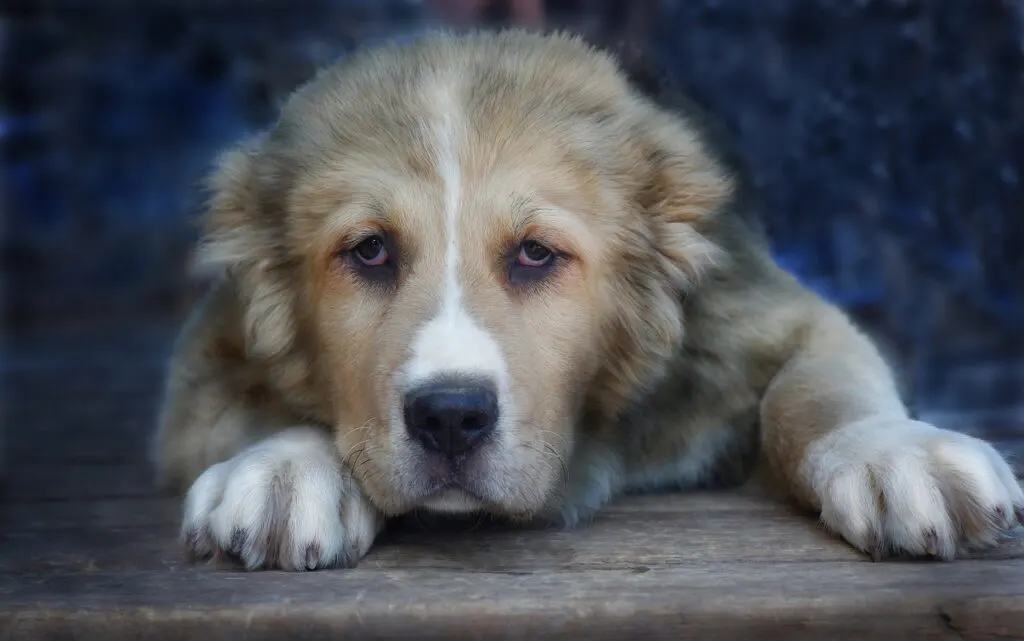Central Asian Shepherd Dog
|
Prefer listening over reading? We got you covered!
Getting your Trinity Audio player ready...
|
The Central Asian Shepherd Dog, often referred to as the “Alabai” or “Central Asian Ovtcharka”, is a majestic and ancient large breed. These dogs are renowned for their formidable strength and unwavering loyalty. The breed originates from the vast and rugged landscapes of Central Asia. These dogs have served as guardians and protectors for nomadic tribes and livestock for centuries. This breed is unique and has many special qualities. We will look at its history, temperament, and what it needs to stay healthy and happy.
Quick Facts
Origin: Central Asian Shepherds originate from the vast Central Asian region.
Size: They stand 24-32 inches tall at the shoulder. Central Asian Shepherds typically weigh between 100-150 pounds.
Breed Group: Central Asian Shepherds belong to the working dog group.
Lifespan: Their average lifespan is 10-12 years.
Coat: They possess a dense double coat that comes in various colors, including white, black, brindle, and cream.
Temperament: Central Asian Shepherds are renowned for their independence, unwavering loyalty, protective nature, and strong territorial instincts.
Exercise Needs: These dogs require a substantial amount of physical activity, typically needing 60-90 minutes of exercise daily to stay healthy and content.
Training: Early socialization and consistent training are essential. Central Asian Shepherds can be somewhat strong-willed learners.
Health: While generally robust, they can be prone to certain health issues such as hip dysplasia, elbow dysplasia, and bloat. Regular veterinary check-ups are advisable to ensure their well-being.
Breed History
You’ll be fascinated to learn that the history of the Central Asian Shepherd Dog dates back over 5,000 years. This breed has a rich and ancient lineage. The breed was developed out of necessity by nomadic tribes in the Central Asian region. These dogs were bred to protect livestock from predators. They were also used to guard their owners’ possessions.
They played a crucial role in the survival of these tribes. They provided security and companionship. The Central Asian Shepherd Dog breed standard was created in the 1920s by the USSR. The breed is still used as working dogs today. Their strong protective instincts and territorial nature make them excellent guard dogs.
Despite their long history, they remain relatively unknown outside of their native regions.
Did You Know?
| 1 | 2 | 3 | 4 |
|---|---|---|---|
| This large and powerful dog is thought to have descended from ancient Tibetan Mastiff dogs. Its origins can be traced back over 5,000 years ago. | This is not a man-made breed. As far as we can tell, the Central Asian Shepherd developed on its own over the years through natural selection. | The Alabai proudly represents Turkmenistan as its national symbol. The country even built a stunning 19-foot-tall golden statue of this dog. | The Central Asians are one of the most popular dog breeds in Russia and the former Soviet Union. |
Asian Shepherd Dog Breed Information
With its massive size, robust body, and triangular ears, the Central Asian Shepherd Dog is easily recognizable. This unique breed is known for its strong physical characteristics. It sets it apart from other dogs.
The Central Asian Shepherd Dog may weigh up to 150 pounds and has a large, moderately long, and robust body. Its triangular ears add to its distinctive appearance.
In terms of coat, this breed has a straight, coarse undercoat with short, dense hair on the head and front limbs. The outer coat can be either short or long and comes in various colors except blue and brown.
Temperament and Personality Traits of the Central Asian Shepherd Dog
If you’re looking for a loyal and protective companion, the purebred Central Asian Shepherd is a truly independent breed. This breed has a reputation for being fiercely protective of their loved ones and their territory. They are not suitable for first-time pet owners or apartment living due to their stubborn nature and need for attention.
The Central Asian Shepherd loves to dig and bark, so they require proper training to become well-behaved companions and watchdogs.
Training and Socialization for the Central Asian Shepherd Dog
Training and socialization are essential for the Central Asian Shepherd. This breed has a strong temperament and can be challenging to train. To ensure a well-behaved dog, consider the following:
- Start early: Begin training and socialization of your puppy from a young age. Establish good habits and manners. Early exposure to different people, animals, and environments will help them become more adaptable.
- Be patient and consistent: The Central Asian Shepherd can be a stubborn pup at times. It’s important to stay calm and consistent in your training methods. Use positive reinforcement techniques like treats or praise to motivate them.
- Provide mental stimulation: This breed is intelligent and needs mental stimulation to prevent boredom. Incorporate interactive toys, nose work, and puzzle games. Consider nose work or obedience training sessions in their daily routine.
Health Issues and Care for the Central Asian Shepherd Dog
When it comes to the health of your Central Asian Shepherd, regular veterinary checkups and early detection of potential issues are important. This breed is generally genetically resilient. They may be prone to elbow and hip dysplasia due to their size. It’s crucial to have a veterinarian monitor their joints and provide appropriate care if needed. In addition, maintaining good dental hygiene is essential for their overall health. Brushing their teeth at least three times a week and scheduling regular dental cleanings will help prevent dental diseases. To emphasize the importance of these healthcare practices, here is a table showcasing the key aspects:
| Key Aspects | Importance |
|---|---|
| Regular Veterinary Checkups | Early detection of potential issues |
| Monitoring Joint Health | Prevention and treatment of hip and elbow dysplasia |
| Dental Hygiene | Prevention of dental diseases |
Feeding and Nutrition for the Central Asian Shepherd Dog
Feeding and nutrition for the Central Asian Shepherd is crucial to maintaining their overall health and well-being. To ensure that your Central Asian Shepherd gets the proper nourishment, here are three important guidelines to follow:
Provide a well-balanced diet: Your Central Asian Shepherd needs a diet that is rich in nutrients and properly proportioned. Consult with a veterinarian to determine the best feeding plan for your dog’s specific needs.
Monitor food intake: It’s important to keep an eye on how much dog food your Central Asian Shepherd is consuming. Overfeeding can lead to weight gain, which can put a strain on their joints and overall health. Be mindful of portion sizes and avoid excessive treats.
Regular veterinary check-ups: Regular visits to the veterinarian will help ensure that your Central Asian Shepherd is receiving the appropriate nutrition for their age and any specific health concerns they may have. The vet can also provide guidance on dietary changes as your dog ages or if they develop any medical issues.
Exercise and Activity Requirements for the Central Asian Shepherd Dog
To keep your Central Asian Shepherd healthy and fulfilled, it’s important to provide regular exercise and engage them in various activities. This breed requires about an hour of exercise per day to maintain their physical and mental well-being. You can meet their exercise needs by taking them for long walks. Play games like fetch or tug-of-war. Participate in dog sports such as agility or obedience training. Provide them with mental stimulation. Give them puzzle toys. Introduce nose work or interactive games to help prevent boredom and destructive behaviors.

Grooming Tips for the Central Asian Shepherd Dog
Regular brushing is essential for maintaining the coat of a Central Asian Shepherd. Here are three grooming tips to keep your dog looking their best:
1. Brush their coat at least once a week: Central Asian Shepherds have a medium-length, dense coat. It can get tangled and matted if not properly maintained. Regular brushing helps to remove loose fur. This prevents matting, and distributes natural oils throughout the coat.
2. Pay attention to shedding seasons: These dogs go through an annual shed known as the ‘fur storm.’ During this time, daily brushing is necessary to manage the amount of hair they lose. Be prepared with proper grooming tools. Dedicate extra time to keep their coat in good condition.
3. Don’t forget about dental care: Good oral hygiene is important for your dog’s overall health. Brush their teeth regularly using canine toothpaste. Provide them with appropriate chew toys or dental treats. This will help keep their teeth clean and strong.
Living With a Central Asian Shepherd Dog: Family and Home Considerations
Living with a Central Asian Shepherd can be a rewarding experience. They are loyal and protective family dogs. These dogs have a strong bond with their families and will go to great lengths to protect them. They are known for their independence. They are very affectionate towards loved ones and good with children.
While they may be aloof with strangers, Central Asian Shepherds usually get along well with cats and other dogs. It is important to teach children how to behave around these large and strong animals. Make sure to always supervise their interactions.
Central Asian Shepherds can adapt well to apartment living if they receive enough playtime and do not excessively bark.
Central Asian Shepherd Dog Breed Standards and Organizations
The breed standards and organizations for Central Asian Shepherds ensure the preservation of the breed’s unique characteristics. They also promote responsible ownership. These standards and organizations play a crucial role in maintaining the integrity of the breed. They ensure that Central Asian Shepherds are bred according to specific criteria.
1. Breed Standards: Central Asian Shepherds have specific physical traits that define their appearance. Particularly their massive size, triangular ears, and thick tail. Breed standards outline these characteristics to ensure consistency in the breed.
2. Health Testing: Responsible organizations require health testing for breeding dogs to identify any potential genetic health conditions. This helps maintain the overall health and well-being of the breed.
3. Ethical Ownership: Organizations promote responsible ownership. They educate prospective owners about the needs and temperament of Central Asian Shepherds. They encourage proper training, socialization, and care. All this to ensure these dogs thrive in their homes.
Final Thoughts
Owning a Central Asian Shepherd Dog requires dedication and experience. They are not suitable for first-time pet owners or apartment living. However, with proper training and socialization, they can be excellent companions and watchdogs.
This breed has a long history and is still used as guard dogs by nomadic tribes. To ensure their well-being, provide them with a nutritious diet, regular grooming, dental care, and daily exercise.




















